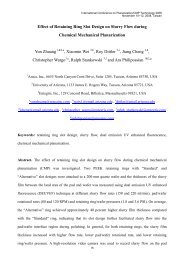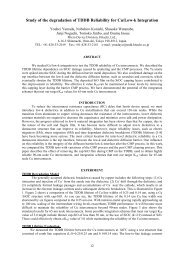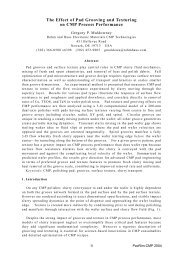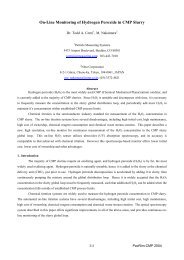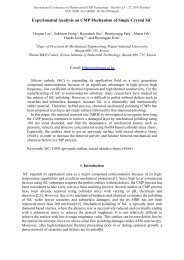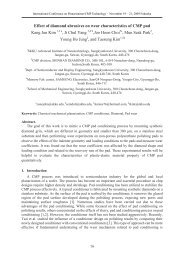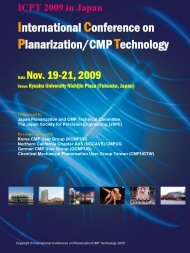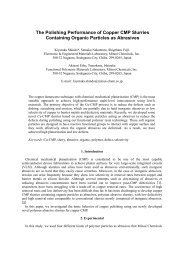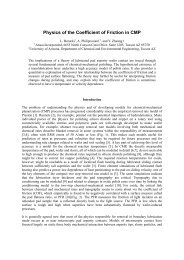A Study of Copper Corrosion for a Cleaning Process with Quartz ...
A Study of Copper Corrosion for a Cleaning Process with Quartz ...
A Study of Copper Corrosion for a Cleaning Process with Quartz ...
Create successful ePaper yourself
Turn your PDF publications into a flip-book with our unique Google optimized e-Paper software.
International Conference on Planarizaiton/CMP Technology ・ November 19 – 21, 2009 Fukuoka<br />
A <strong>Study</strong> <strong>of</strong> <strong>Copper</strong> <strong>Corrosion</strong> <strong>for</strong> a <strong>Cleaning</strong> <strong>Process</strong> <strong>with</strong> <strong>Quartz</strong> Crystal<br />
Microbalance and Comb Electrodes<br />
Shohei Shima, Yutaka Wada, Katsuhiko Tokushige, Akira Fukunaga, and<br />
Manabu Tsujimura<br />
Precision Machinery Company, Ebara Corporation<br />
4-2-1 Honfujisawa, Fujisawa-shi 251-8502, Japan<br />
E-mail: shima.shohei@ebara.com<br />
Keywords: copper, corrosion, quartz crystal microbalance, comb electrode, dissolved oxygen,<br />
conductivity<br />
Abstract. We used a 10 MHz quartz crystal microbalance (QCM) to detect small mass changes<br />
during the copper surface cleaning process. The geometrical effect <strong>of</strong> galvanic corrosion, such as<br />
the cathode-to anode area ratio was quantitatively determined and we found that the etching rate<br />
was proportional to the square root <strong>of</strong> the area ratio. <strong>Corrosion</strong> phenomena in de-ionized water<br />
(DIW) were clarified in terms <strong>of</strong> dissolved oxygen (DO) and conductivity (S) <strong>of</strong> DIW. It was not<br />
sufficient to suppress the DO concentration in DIW alone to decrease the copper corrosion rate.<br />
Suppression <strong>of</strong> DIW conductivity also becomes necessary when a potential difference exists on Cu<br />
films locally. The time constant <strong>for</strong> the diffusion <strong>of</strong> oxygen into a DIW layer was 0.6 sec in a 10<br />
um layer and 0.06 sec in a 1 um layer. This shows that the oxygen diffusion into DIW is<br />
significantly fast. We were able to estimate that in an actual spin-rinse-dry (SRD) process, the<br />
DIW layer was immediately saturated in oxygen in atmospheric conditions.<br />
Introduction<br />
During chemical mechanical planarization (CMP), post-CMP cleaning has been one <strong>of</strong> the critical<br />
processes influencing the yield <strong>of</strong> devices [1]. It is required <strong>for</strong> etching <strong>of</strong>f particles and residues<br />
from the surface <strong>of</strong> copper <strong>with</strong>out roughening the surface during the cleaning process. On the<br />
other hand, during the polishing process, we can add the chelate agents into slurries to <strong>for</strong>m a thick<br />
passivation layer on the polishing surface. During the cleaning process, the thickness <strong>of</strong> the<br />
paasivated surface layer needs to be as thin as possible to maintain good adhesion to the insulating<br />
layer above it and to have a low contact resistance in the via hole. For this reason, Cu corrosion<br />
susceptibly is remarkably low during the cleaning process. We conducted a Cu corrosion study<br />
<strong>with</strong> a quartz crystal microbalance (QCM) [2-4] to detect small changes in mass, and used comb<br />
electrodes to detect the conductivity <strong>of</strong> electrolyte. We examined the effect <strong>of</strong> both dissolved<br />
oxygen (DO) and conductivity on Cu corrosion in de-ionized water (DIW) and citric acid. The<br />
comb electrodes were used to detect the DO change in the spin-rinse-dry (SRD) process.<br />
Experimental<br />
<strong>Copper</strong> corrosion phenomena were evaluated using a potentiostat system <strong>with</strong> three electrodes and<br />
the etching rate was measured <strong>with</strong> a QCM used as a working electrode as shown in Fig.1. The<br />
frequency <strong>of</strong> the QCM was 10 MHz and the electrode area was 3 mm in diameter, so we were able<br />
to detect mass changes as small as 0.31 ng/Hz. <strong>Copper</strong> films were sputtered on an Au electrode <strong>of</strong><br />
the QCM using a metal mask. The area <strong>of</strong> the counter electrode is typically 3 cm 2 and we used<br />
Ag/AgCl as a reference electrode.<br />
229
International Conference on Planarizaiton/CMP Technology ・ November 19 – 21, 2009 Fukuoka<br />
We used DIW and citric acid as electrolytes <strong>for</strong> our corrosion study and examined the<br />
dependence <strong>of</strong> the etching rate on concentration <strong>of</strong> DO and on the conductivity (S) <strong>of</strong> the<br />
electrolytes. DO was adjusted by N 2 bubbling in DIW and S was controlled using Na 2 SO 4 as a<br />
supporting electrolytes. We measured DO and S by commercial meters in bulk electrolyte. In the<br />
CMP process, many SRD systems were used in CMP equipments. The thickness <strong>of</strong> the electrolyte<br />
layer on the wafer may actually be less than several hundred micro meters in the SRD process, so<br />
we tried to estimate DO and S in the thin layer <strong>of</strong> electrolyte <strong>with</strong> a comb electrode as shown in<br />
Fig.2. The comb electrode was made <strong>of</strong> gold and patterned <strong>with</strong> lines and spaces <strong>of</strong> 2 um <strong>with</strong> 65<br />
fins, and the total space length was 130 mm. We dispensed drops <strong>of</strong> DIW into the window <strong>of</strong> a<br />
comb electrode using a pipet and monitored the resistivity change between two electrodes (W1<br />
and W2) .<br />
Results and Discussion<br />
Galvanic effects<br />
Figure 3 shows the galvanic corrosion rate in three different systems <strong>of</strong> Cu/Cu, Cu/Ta and Cu/Ru<br />
in 0.5 mole/l citric acid. The etching rate in the Cu/Cu system is nearly zero, because both <strong>of</strong> the<br />
anode (QCM) and the cathode (CE) are composed <strong>of</strong> the same material and the potential difference<br />
between the two electrodes is zero. We measured the oxidation reduction potential <strong>for</strong> Cu and Ta,<br />
and they were – 20 mV and -79 mV respectively. In the Cu/Ta system, Cu was nobler than Ta in<br />
citric acid and, as a result Cu could not be etched. On the other hand, the oxidation reduction<br />
potential <strong>of</strong> Ru was 651 mV and Ru is significantly nobler than Cu. The potential difference<br />
between Cu and Ru was 671 mV, so that the etching rate <strong>of</strong> Cu was markedly large due to the<br />
galvanic effect.<br />
It is said that galvanic corrosion is influenced by geometrical effects such as the anode-tocathode<br />
area ratio; an increasing in the etching rate occurs when the ratio <strong>of</strong> anode to cathode<br />
becomes large. The QCM area is constant and we can not change the anode area, so we varied the<br />
cathode area <strong>of</strong> Ru. Figure 4 shows the etching rate and corrosion current dependency on the area<br />
ratio <strong>of</strong> the cathode (Ru ) by the anode (Cu-QCM) in the Cu/Ru system. Both etching rate and<br />
corrosion current increased as the area ratio increased and it was quantitatively found that the<br />
proportionality factor was equal to the square root <strong>of</strong> the area ratio.<br />
Conductivity and dissolved oxygen effects<br />
Figure 5 shows the relation between the Cu etching rate and the anodic potential <strong>for</strong> DIW and<br />
citric acid <strong>with</strong> varying the conductivity. DO was saturated and nearly 8 ppm in all conditions <strong>of</strong><br />
DIW and citric acid. In the case <strong>of</strong> DIW <strong>with</strong>out Na 2 SO 4 , there was no corrosion even at oxidation<br />
potential <strong>of</strong> 210 mV. However, <strong>with</strong> the addition <strong>of</strong> Na 2 SO 4 , Cu is easily corroded and this shows<br />
that corrosion in DIW is very sensitive to the conductivity <strong>of</strong> DIW. On the other hand, the effect <strong>of</strong><br />
conductivity on the etching rate is smaller in citric acid. The effects <strong>of</strong> both conductivity and DO<br />
will be discussed more precisely, later (see Fig.7).<br />
We examined the effect <strong>of</strong> the supporting electrolyte on the electrode reaction <strong>of</strong> electrochemicals.<br />
All data in Fig.5 is plotted in relation to the corrosion current in Fig.6. All experimental data are<br />
aligned in a straight line. This result shows that Na 2 SO 4 works as a conductivity controlling agent<br />
alone and does not affect the electrode reaction. We found that Cu was ionized as cupric ions, Cu<br />
++, both in DIW and in citric acid, by calculating and comparing the amount <strong>of</strong> total coulomb<br />
consumed in the reaction and the etched mass <strong>of</strong> Cu.<br />
Figure 7 shows the dependence <strong>of</strong> the etching rate on the conductivity <strong>of</strong> both in DIW and<br />
citric acid <strong>with</strong> the addition <strong>of</strong> Na 2 SO 4 <strong>of</strong> 0.01, 0.1 and 1 mole/l. The etching rate is very low at 0<br />
230
International Conference on Planarizaiton/CMP Technology ・ November 19 – 21, 2009 Fukuoka<br />
mV potential both in DIW and in citric acid, even in high conductivity and high DO conditions.<br />
The etching rate increases at a higher potential where oxidation initiates at the Cu QCM electrode.<br />
We examined the effect <strong>of</strong> DO on the etching rate by controlling the DO concentration <strong>with</strong> N 2<br />
bubbling in the electrolyte. In the case <strong>of</strong> citric acid, the etching rate was extremely reduced by<br />
decreasing the DO concentration to 0.6 ppm by N 2 bubbling, even at 100 mV potential. However,<br />
the amount <strong>of</strong> reduction in the etching rate in DIW is smaller than that <strong>of</strong> citric acid. A further<br />
decrease in the etching rate can be accomplished by decreasing the conductivity in DIW. These<br />
results suggest that the concentrations <strong>of</strong> both DO and conductivity should be suppressed to avoid<br />
corrosion in the DIW cleaning process. In citric acid, the surface <strong>of</strong> Cu is more effectively<br />
passivated <strong>with</strong> a complex layer <strong>of</strong> citrate in a lower DO concentration, independent <strong>of</strong><br />
conductivity.<br />
DO change <strong>of</strong> DIW due to the dissolution <strong>of</strong> oxygen from air<br />
We examined the DO concentration decrease <strong>with</strong> N 2 bubbling at first, followed by the<br />
measurement <strong>of</strong> the DO increase due to the dissolution <strong>of</strong> oxygen from air using a DO meter. A<br />
decrease in DO concentration is rapid at the time constant <strong>of</strong> about 50 sec in 300 ml DIW <strong>with</strong> 1<br />
litter/min N 2 bubbling. However, a DO increase due to the dissolution <strong>of</strong> oxygen from air is<br />
markedly slow at the time constant <strong>of</strong> about 660 sec, as shown in Fig.8. We monitored the<br />
conductivity change <strong>of</strong> DIW <strong>with</strong> a conductivity meter and the conductivity also increased <strong>with</strong><br />
nearly the same time constant. This result shows that we can monitor the conductivity <strong>of</strong> DIW <strong>with</strong><br />
a direct relation to the DO change.<br />
Estimation <strong>of</strong> DO change <strong>of</strong> thin layer <strong>of</strong> DIW <strong>with</strong> comb electrode<br />
Figure 9 shows the resistivity change <strong>of</strong> a small droplet <strong>of</strong> DIW <strong>with</strong> a low DO concentration on an<br />
Au comb electrode due to the dissolution <strong>of</strong> oxygen from air. The time constant <strong>of</strong> the droplet is<br />
about 100 sec in 10 micro litters and in a larger droplet <strong>of</strong> 50 micro litters shows a larger value <strong>of</strong><br />
181 sec. We think this is dependent upon the thickness <strong>of</strong> the droplet, more specifically, on the<br />
oxygen diffusion from surface to bottom at the comb electrode. We assume that the shape <strong>of</strong><br />
droplet could be half <strong>of</strong> a sphere, and estimate the thickness <strong>of</strong> the droplet. Figure 10 shows the<br />
relation between the thickness <strong>of</strong> the DIW layer <strong>of</strong> a droplet and the time constant. The two results<br />
show a linear relationship, which allows us to estimate the time constant <strong>of</strong> thinner DIW layers. In<br />
an SRD system, the water layer on a wafer during the DIW cleaning process may be less than 100<br />
um, so we estimate that the time constant is 6sec, 0.6 sec and 0.06 sec at 100 um, 10 um and 1 um,<br />
respectively. During the SRD process, the DIW layer becomes thinner proceeding the drying<br />
process. This result showed that during the SRD process in air, the DO concentration becomes<br />
greater and immediately saturated. If the wafer has a potential non-uni<strong>for</strong>mity locally, the Cu film<br />
on the wafer is apt to corrode easily when DIW has a high conductivity even <strong>with</strong> a low DO<br />
concentration at first.<br />
Summary<br />
We can evaluate the corrosion phenomena easily and precisely in a quantitative manner using the<br />
QCM technique. In galvanic corrosion, the etching rate depends on the electrode area ratio <strong>with</strong><br />
the square root <strong>of</strong> the anode-to-cathode ratio. It is not sufficient to suppress DO concentration in<br />
DIW to decrease corrosion. The conductivity <strong>of</strong> DIW must also be suppressed when a potential<br />
difference exists locally on Cu films. The diffusion <strong>of</strong> oxygen into a DIW layer is markedly fast on<br />
231
International Conference on Planarizaiton/CMP Technology ・ November 19 – 21, 2009 Fukuoka<br />
a thin layer on a wafer. In the actual SRD process in air, the DIW layer is immediately saturated in<br />
oxygen when in atmospheric conditions.<br />
Acknowledgement<br />
We would like to acknowledge Jung-whan Lee and Min-soo Kim <strong>of</strong> Hanyang University <strong>for</strong> their<br />
help in measuring the etching rate <strong>of</strong> Cu films depending on DO and conductivity. We also wish to<br />
show our appreciation to Pr<strong>of</strong>essor Park, who arranged the internship between Ebara and Hanyang<br />
University.<br />
References<br />
[1] M. Imai, Y. Yamashita, T. Futatsuki, M. Shinohara, S. Kondo and S. Saito: Effect <strong>of</strong> Dissolved<br />
Oxygen on Cu <strong>Corrosion</strong> in Single Wafer <strong>Cleaning</strong> <strong>Process</strong>, Jpn. J. <strong>of</strong> Appl. Phys., 48 (2009),<br />
pp 04C023 1-4.<br />
[2] S. Zakipour, C. Leygraf and G. Portn<strong>of</strong>f: Studies <strong>of</strong> <strong>Corrosion</strong> Kinetics on Electrical Contact<br />
Materials by Means <strong>of</strong> <strong>Quartz</strong> Crystal Microbalance and XPS: J.Electrochm.Soc., 133 (1986),<br />
pp 873-876.<br />
[3] W. Lu, J. Zhang, F. Kaufman and A.C. Hiller: A Combined Triboelectrochemical QCM <strong>for</strong><br />
Studies <strong>of</strong> the CMP <strong>of</strong> <strong>Copper</strong>, J.Electrochem.Soc., 152 (2005), pp B17-22.<br />
[4] D.W. Peters: Incorporation <strong>of</strong> Cu Passivation in Post-CMP Cleaners, ECS Transactions, 11<br />
(2) (2007), pp 447-454.<br />
Figure 1. Etching rate evaluation system<br />
using QCM and potentiostat.<br />
Figure 2. Layout <strong>of</strong> Au comb electrode.<br />
232
International Conference on Planarizaiton/CMP Technology ・ November 19 – 21, 2009 Fukuoka<br />
Figure 3. Galvanic corrosion rate <strong>for</strong><br />
three metal system.<br />
Figure 4. Electrode area ratio dependence<br />
on etching rate and corrosion current in<br />
Cu/Ru system.<br />
Figure 5. Comparison <strong>of</strong> etching rate <strong>of</strong><br />
DIW and Citric acid <strong>for</strong> concentration <strong>of</strong><br />
supporting electrolytes.<br />
Figure 6. Relation between etching rate<br />
and corrosion current <strong>for</strong> all data.<br />
Figure 7. Conductivity effects on etching<br />
rate <strong>for</strong> DIW and citric acid.<br />
Figure 8. Changes <strong>of</strong> DO and S during<br />
oxygen dissolution in DIW in air.<br />
233
International Conference on Planarizaiton/CMP Technology ・ November 19 – 21, 2009 Fukuoka<br />
Figure 9. Resistance change between Au<br />
comb electrodes during oxygen<br />
dissolution in air.<br />
Figure 10. Time constant <strong>of</strong> small droplet<br />
dipped on comb electrodes and estimated<br />
value <strong>of</strong> thin DIW layer.<br />
234



